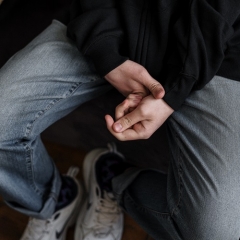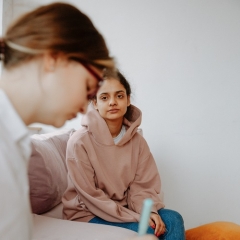Cognitive Behavioural Therapy (CBT)
❇️ CBT is a type of psychological intervention where the therapist helps the client identify negative patterns that have arisen in the way they think and feel, that have led to issues such as anxiety and depression, as well as other mental and emotional difficulties.
❇️ CBT focuses on the present time, and current problems and how patterns that have built up are impacting a client’s daily life. CBT breaks these patterns down into the way in which thoughts, actions, feelings, and felt physical sensations are connected, and can link in a viscous cycle where daily life is impacted. Once identified, patterns can be changed, and this can lead to improvement in clients’ wellbeing and mental health.
❇️ CBT is normally a brief therapy, with 6-20 weekly sessions, depending upon the issues presenting. Exercises are given to be completed by the client between sessions and to enable the client to learn approaches and develop tools they can use themselves on an ongoing basis.
❇️ CBT combines two main approaches to understanding the mind and behaviour; Cognitive therapy, and Behavioural Therapy.
❇️ Cognitive therapy recognises the power of beliefs, whereby unhelpful beliefs can stop people from moving on. By testing and challenging these beliefs, space is made to develop new ideas and approaches that may be more helpful, and which can be tested out between sessions. This is geared toward future and moving forward.
❇️ Behavioural therapy examines problems from the viewpoint of how a person behaves. Examples are needing to overcome a phobia, where gradually the person is exposed to the thing that is feared, in a controlled manner, in order to be more relaxed and comfortable in the situation.
❇️ CBT is used in personality disorder, phobia, Obsessive Compulsive Disorder, eating disorders such as bulimia and anorexia, panic disorder, substance addition and misuse, psychosis and schizophrenia.
❇️ NICE (the National Institute for Clinical Excellence, which tells NHS doctors which treatments to use for diseases and conditions) recommends CBT as part of its 2022 guidelines for depression in adults with chronic depressive symptoms (NICE NG222; 1.10.2), and in combination with medication for people with depression who also have a diagnosis of personality disorder (NICE NG222; 1.11.2).
❇️ NICE also recommends CBT as part of an approach to managing chronic pain in its guidelines (see link to blog below – CG193).
❇️ NICE also recommends CBT as part of stepped care for Generalised Anxiety Disorder (GAD) [CG113]; Social anxiety disorder) [CG159]; Panic disorder; Eating disorders [NG69]; OCD (obsessive compulsive disorder) and body dysmorphic disorder, (BDD) [CG31]; PTSD (post traumatic stress disorder); tinnitus related distress [NG155] as well as depression and mild to moderate common mental health disorders (NICE CG123; 1.4.2. onward.
References:
Depression in adults: treatment and management
NICE guideline [NG222]Published: 29 June 2022
Obsessive-compulsive disorder and body dysmorphic disorder: treatment
Clinical guideline [CG31]Published: 29 November 2005
Common mental health problems: identification and pathways to care
Clinical guideline [CG123]Published: 25 May 2011
Social anxiety disorder: recognition, assessment and treatment
Clinical guideline [CG159]Published: 22 May 2013
Eating disorders: recognition and treatment
NICE guideline [NG69]Published: 23 May 2017 Last updated: 16 December 2020
Tinnitus: assessment and management
NICE guideline [NG155]Published: 11 March 2020
Generalised anxiety disorder and panic disorder in adults: management
Clinical guideline [CG113]Published: 26 January 2011 Last updated: 15 June 2020
Blogs:
NICE recommends Chronic Primary Pain Treatments: Acupuncture and talking therapies; CBT and ACT













